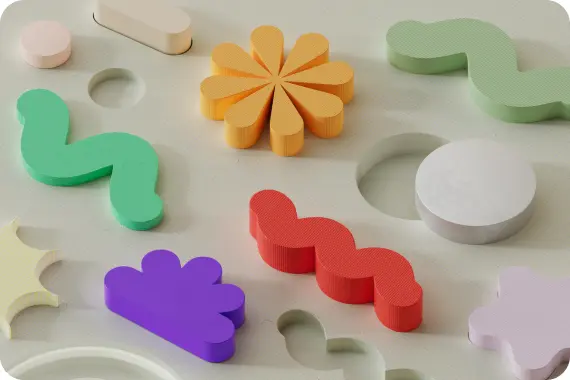
Designing with people who can’t see
2025-04-02
Imagine André, a man in his thirties, running his fingers over a LEGO model of a webpage. His fingers find a brick with a raised ‘X’—he presses the button, and his screen reader confirms its purpose. He pauses, smiles, and rearranges the blocks. “The exit button should be here,” he says. “It’s where I’d expect it.”
Designing with people with visual impairments challenges us to rethink how we listen, adapt, and build tools that belong to their users. Here’s what co-designing TOMAT Navigator with visually impaired communities taught us about participatory design—and why it matters for everyone.
1. Let people build their own experience
André didn’t just use prototypes—he remixed them. Swapping modular buttons, tweaking layouts, and even declaring AI roles for his workflow. The key to balance powerful features with simple and intuitive experiences? A core system simple enough for anyone, extensible enough for everyone.
The bigger picture
* Try this: in prototypes and design workshops, create space for flexibility and let users reveal what they need and the experience they’re looking for.
One size rarely fits all. The best tools aren’t finished products—they’re flexible platforms, shaped by the people who use them.
2. Beyond screens and words
André does not navigate screen layouts—he navigates relationships between elements, just as he navigates streets or the chapters of a book. For him, malleable prototypes bridged the gap between abstract concepts and tangible understanding, letting him intuitively reshape these relationships by moving bricks around. A concept isn’t just a colored square on the screen—it’s a physical shape, a texture, a sound.
The bigger picture
* Try this: replace abstract icons with tangible metaphors—prototype a scrollbar as a volume slider, or use a measuring tape as a menu that unfurls.
Good design isn’t just about adding feedback—it’s about making technology speak human through all the senses.
3. Balance innovation and familiarity
André doesn’t approach the digital world as a blank slate—he brings a well-worn set of tools and strategies shaped by years of navigating digital, physical, and social systems. These aren’t learned from manuals, but through lived experience: trial, error, repetition. His way of interacting isn’t something to overwrite—it’s something to build on. When design respects that foundation, it doesn’t take control away; it opens up new possibilities within familiar ground. It’s not about teaching a new system, but meeting him where he is, and letting technology fit the rhythm he already knows.
The bigger picture
Try this: Let users’ existing expertise shape innovation. As André put it, his ideal assistive technology would be “a TV remote for the internet.”
Good design balances innovation with familiarity—it builds on the physical grammar we’ve been using since childhood.
4. Stand on the shoulders of giants
André doesn’t build in isolation—he stands atop decades of collective problem-solving. Tactile feedback patterns, screen reader software, open-source libraries—these aren’t just resources but a shared language refined by countless contributors before him. When André’s team hit a wall, they didn’t reinvent the wheel—they collaborated with community and academic partners to find a wheel and make it roll better.
The bigger picture
Try this: Build on open-source foundations and contribute with community and academic organizations.
Good design is the art of weaving individual expertise into a collective tapestry. The best tools are built with many minds, shaped by real-world use, and handed forward to the next builder.
The takeaway: Design as an open dialogue
The future of accessibility isn’t just about solving technical problems—it’s about redesigning how we solve them. Because when we design with people, not for them, we don’t just make better products. We build a world where everyone has the right to participate—and the power to shape what comes next.
Keep exploring
Check out these related posts for more insights and inspiration.
Want more insights like this?
Subscribe for exclusive blog previews, open-source toolkits, and invites to community co-design


